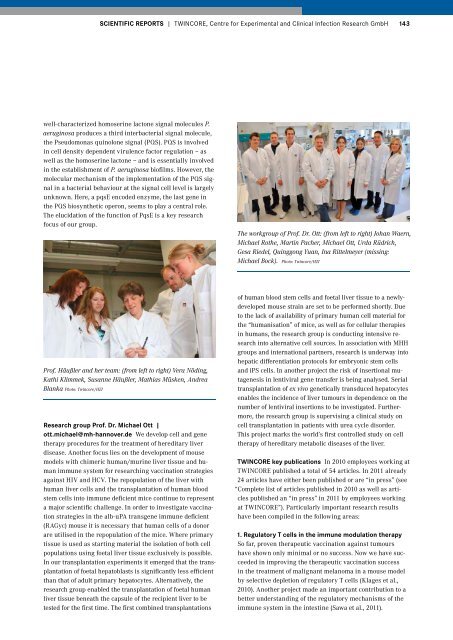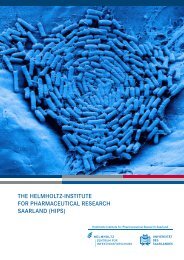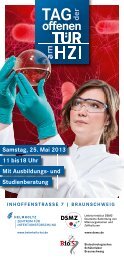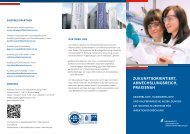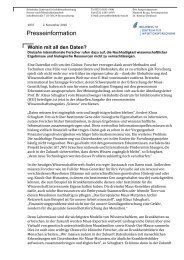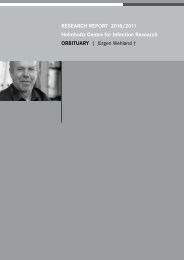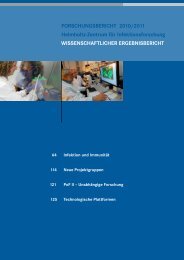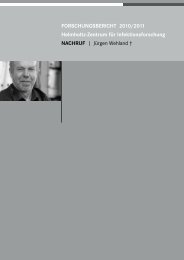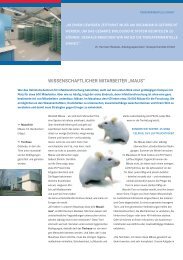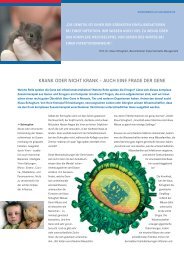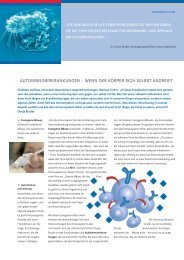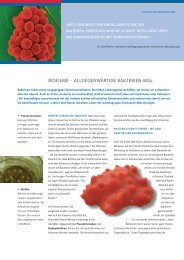Research Report 2010 2011 - Helmholtz-Zentrum für ...
Research Report 2010 2011 - Helmholtz-Zentrum für ...
Research Report 2010 2011 - Helmholtz-Zentrum für ...
Create successful ePaper yourself
Turn your PDF publications into a flip-book with our unique Google optimized e-Paper software.
SCIENTIFIC REPORTS | TWINCORE, Centre for Experimental and Clinical Infection <strong>Research</strong> GmbH<br />
143<br />
well-characterized homoserine lactone signal molecules P.<br />
aeruginosa produces a third interbacterial signal molecule,<br />
the Pseudomonas quinolone signal (PQS). PQS is involved<br />
in cell density dependent virulence factor regulation – as<br />
well as the homoserine lactone – and is essentially involved<br />
in the establishment of P. aeruginosa biofilms. However, the<br />
molecular mechanism of the implementation of the PQS signal<br />
in a bacterial behaviour at the signal cell level is largely<br />
unknown. Here, a pqsE encoded enzyme, the last gene in<br />
the PQS biosynthetic operon, seems to play a central role.<br />
The elucidation of the function of PqsE is a key research<br />
focus of our group.<br />
The workgroup of Prof. Dr. Ott: (from left to right) Johan Waern,<br />
Michael Rothe, Martin Pacher, Michael Ott, Urda Rüdrich,<br />
Gesa Riedel, Quinggong Yuan, Ina Rittelmeyer (missing:<br />
Michael Bock). Photo: Twincore/HZI<br />
Prof. Häußler and her team: (from left to right) Vera Nöding,<br />
Kathi Klimmek, Susanne Häußler, Mathias Müsken, Andrea<br />
Blanka Photo: Twincore/HZI<br />
<strong>Research</strong> group Prof. Dr. Michael Ott |<br />
ott.michael@mh-hannover.de We develop cell and gene<br />
therapy procedures for the treatment of hereditary liver<br />
disease. Another focus lies on the development of mouse<br />
models with chimeric human/murine liver tissue and human<br />
immune system for researching vaccination strategies<br />
against HIV and HCV. The repopulation of the liver with<br />
human liver cells and the transplantation of human blood<br />
stem cells into immune deficient mice continue to represent<br />
a major scientific challenge. In order to investigate vaccination<br />
strategies in the alb-uPA transgene immune deficient<br />
(RAGyc) mouse it is necessary that human cells of a donor<br />
are utilised in the repopulation of the mice. Where primary<br />
tissue is used as starting material the isolation of both cell<br />
populations using foetal liver tissue exclusively is possible.<br />
In our transplantation experiments it emerged that the transplantation<br />
of foetal hepatoblasts is significantly less efficient<br />
than that of adult primary hepatocytes. Alternatively, the<br />
research group enabled the transplantation of foetal human<br />
liver tissue beneath the capsule of the recipient liver to be<br />
tested for the first time. The first combined transplantations<br />
of human blood stem cells and foetal liver tissue to a newlydeveloped<br />
mouse strain are set to be performed shortly. Due<br />
to the lack of availability of primary human cell material for<br />
the “humanisation” of mice, as well as for cellular therapies<br />
in humans, the research group is conducting intensive research<br />
into alternative cell sources. In association with MHH<br />
groups and international partners, research is underway into<br />
hepatic differentiation protocols for embryonic stem cells<br />
and iPS cells. In another project the risk of insertional mutagenesis<br />
in lentiviral gene transfer is being analysed. Serial<br />
transplantation of ex vivo genetically transduced hepatocytes<br />
enables the incidence of liver tumours in dependence on the<br />
number of lentiviral insertions to be investigated. Furthermore,<br />
the research group is supervising a clinical study on<br />
cell transplantation in patients with urea cycle disorder.<br />
This project marks the world’s first controlled study on cell<br />
therapy of hereditary metabolic diseases of the liver.<br />
TWINCORE key publications In <strong>2010</strong> employees working at<br />
TWINCORE published a total of 54 articles. In <strong>2011</strong> already<br />
24 articles have either been published or are “in press” (see<br />
“Complete list of articles published in <strong>2010</strong> as well as articles<br />
published an “in press” in <strong>2011</strong> by employees working<br />
at TWINCORE”). Particularly important research results<br />
have been compiled in the following areas:<br />
1. Regulatory T cells in the immune modulation therapy<br />
So far, proven therapeutic vaccination against tumours<br />
have shown only minimal or no success. Now we have succeeded<br />
in improving the therapeutic vaccination success<br />
in the treatment of malignant melanoma in a mouse model<br />
by selective depletion of regulatory T cells (Klages et al.,<br />
<strong>2010</strong>). Another project made an important contribution to a<br />
better understanding of the regulatory mechanisms of the<br />
immune system in the intestine (Sawa et al., <strong>2011</strong>).


